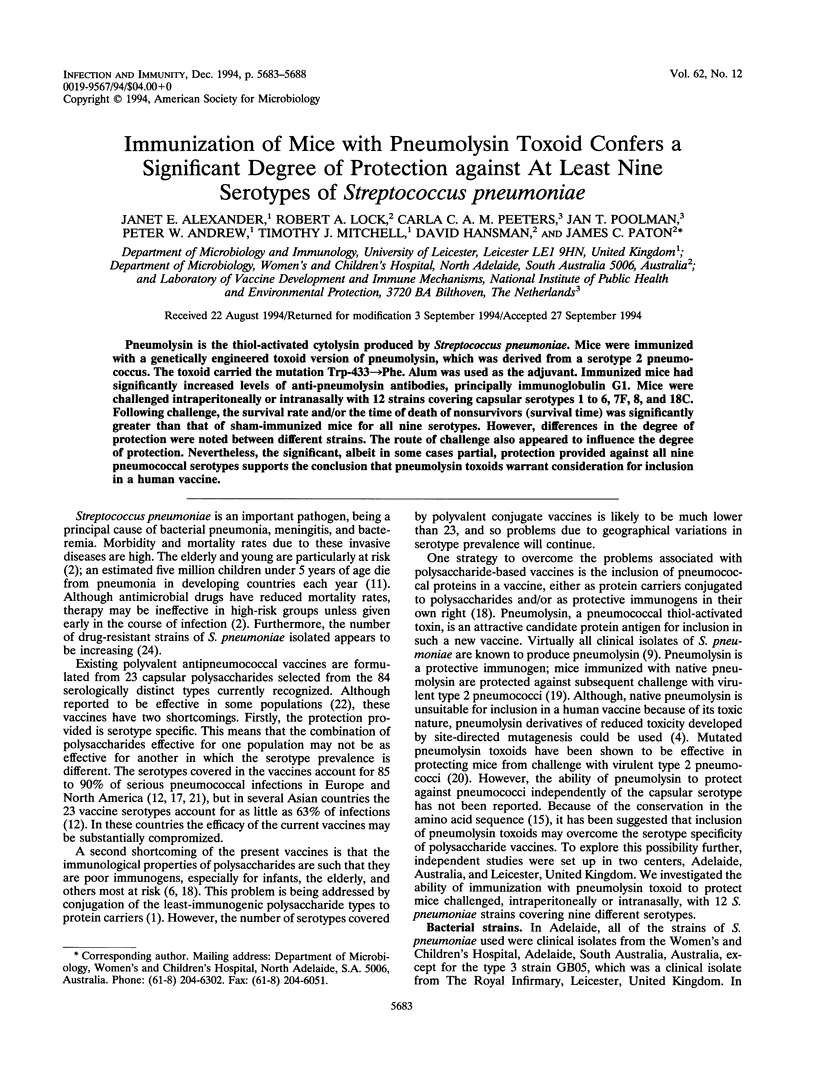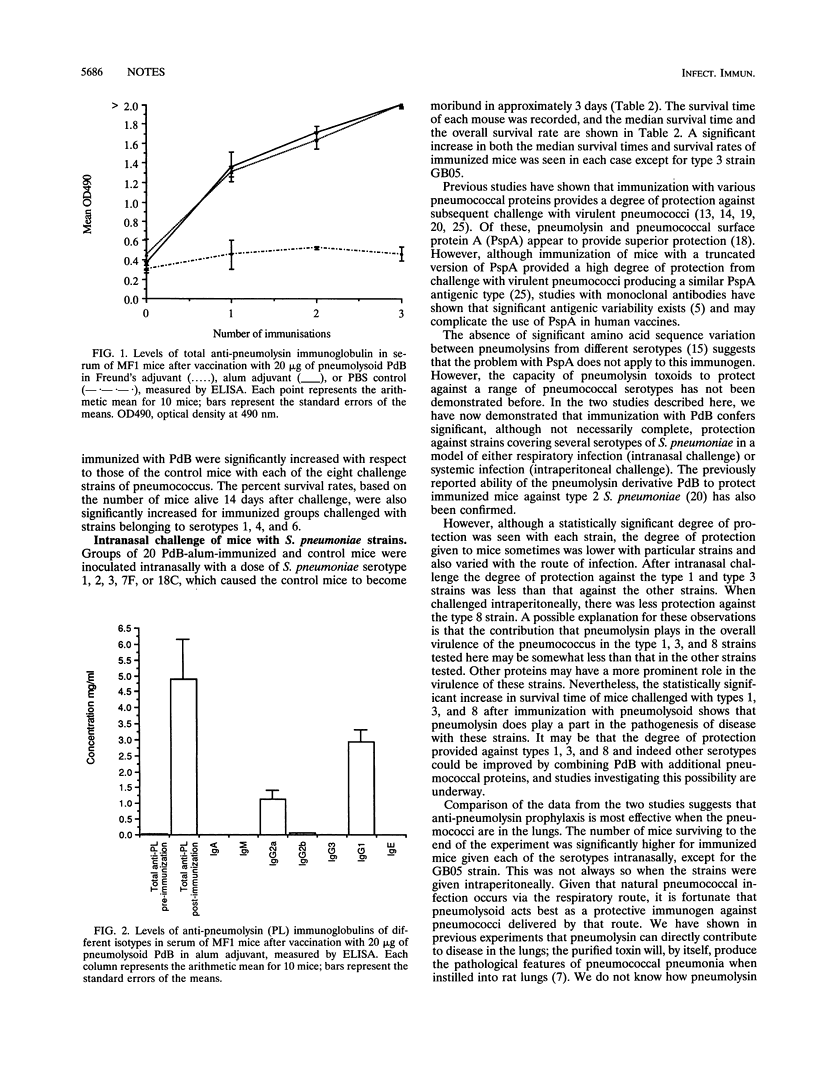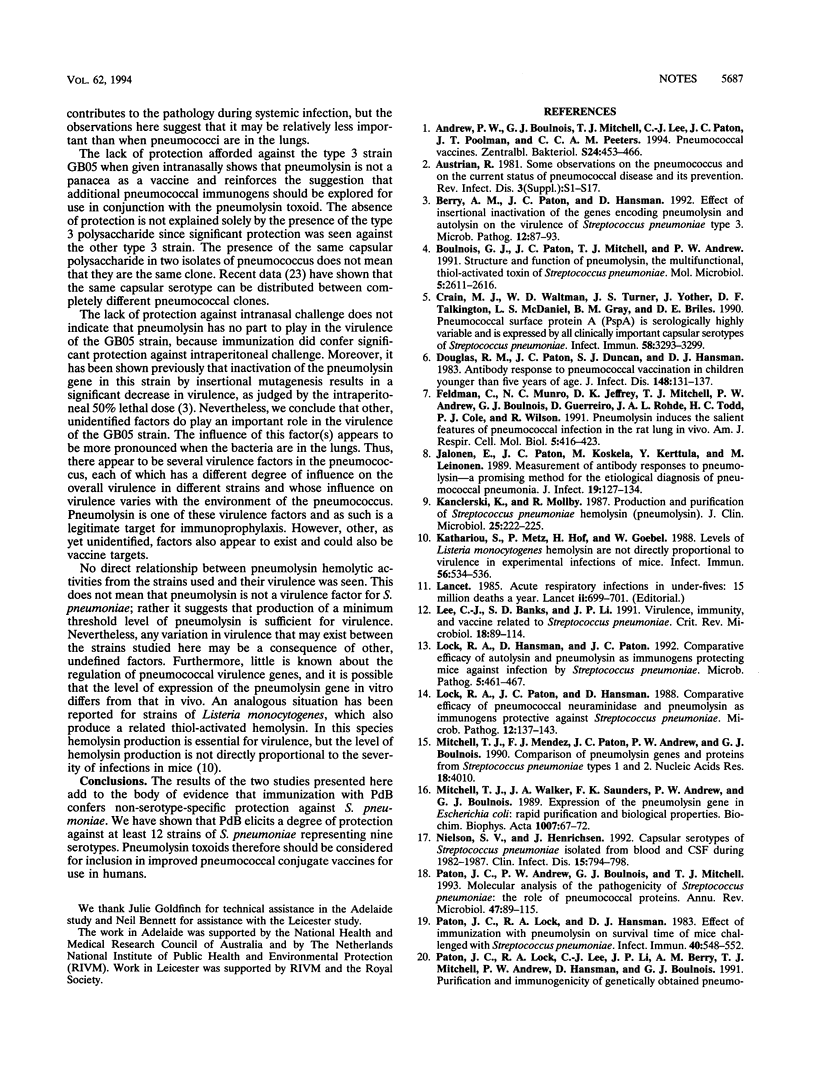Abstract
Pneumolysin is the thiol-activated cytolysin produced by Streptococcus pneumoniae. Mice were immunized with a genetically engineered toxoid version of pneumolysin, which was derived from a serotype 2 pneumococcus. The toxoid carried the mutation Trp-433-->Phe. Alum was used as the adjuvant. Immunized mice had significantly increased levels of anti-pneumolysin antibodies, principally immunoglobulin G1. Mice were challenged intraperitoneally or intranasally with 12 strains covering capsular serotypes 1 to 6, 7F, 8, and 18C. Following challenge, the survival rate and/or the time of death of nonsurvivors (survival time) was significantly greater than that of sham-immunized mice for all nine serotypes. However, differences in the degree of protection were noted between different strains. The route of challenge also appeared to influence the degree of protection. Nevertheless, the significant, albeit in some cases partial, protection provided against all nine pneumococcal serotypes supports the conclusion that pneumolysin toxoids warrant consideration for inclusion in a human vaccine.
Full text
PDF





Selected References
These references are in PubMed. This may not be the complete list of references from this article.
- Austrian R. Some observations on the pneumococcus and on the current status of pneumococcal disease and its prevention. Rev Infect Dis. 1981 Mar-Apr;3 (Suppl):S1–17. doi: 10.1093/clinids/3.supplement_1.s1. [DOI] [PubMed] [Google Scholar]
- Berry A. M., Paton J. C., Hansman D. Effect of insertional inactivation of the genes encoding pneumolysin and autolysin on the virulence of Streptococcus pneumoniae type 3. Microb Pathog. 1992 Feb;12(2):87–93. doi: 10.1016/0882-4010(92)90111-z. [DOI] [PubMed] [Google Scholar]
- Boulnois G. J., Paton J. C., Mitchell T. J., Andrew P. W. Structure and function of pneumolysin, the multifunctional, thiol-activated toxin of Streptococcus pneumoniae. Mol Microbiol. 1991 Nov;5(11):2611–2616. doi: 10.1111/j.1365-2958.1991.tb01969.x. [DOI] [PubMed] [Google Scholar]
- Crain M. J., Waltman W. D., 2nd, Turner J. S., Yother J., Talkington D. F., McDaniel L. S., Gray B. M., Briles D. E. Pneumococcal surface protein A (PspA) is serologically highly variable and is expressed by all clinically important capsular serotypes of Streptococcus pneumoniae. Infect Immun. 1990 Oct;58(10):3293–3299. doi: 10.1128/iai.58.10.3293-3299.1990. [DOI] [PMC free article] [PubMed] [Google Scholar]
- Douglas R. M., Paton J. C., Duncan S. J., Hansman D. J. Antibody response to pneumococcal vaccination in children younger than five years of age. J Infect Dis. 1983 Jul;148(1):131–137. doi: 10.1093/infdis/148.1.131. [DOI] [PubMed] [Google Scholar]
- Feldman C., Munro N. C., Jeffery P. K., Mitchell T. J., Andrew P. W., Boulnois G. J., Guerreiro D., Rohde J. A., Todd H. C., Cole P. J. Pneumolysin induces the salient histologic features of pneumococcal infection in the rat lung in vivo. Am J Respir Cell Mol Biol. 1991 Nov;5(5):416–423. doi: 10.1165/ajrcmb/5.5.416. [DOI] [PubMed] [Google Scholar]
- Jalonen E., Paton J. C., Koskela M., Kerttula Y., Leinonen M. Measurement of antibody responses to pneumolysin--a promising method for the presumptive aetiological diagnosis of pneumococcal pneumonia. J Infect. 1989 Sep;19(2):127–134. doi: 10.1016/s0163-4453(89)91864-1. [DOI] [PubMed] [Google Scholar]
- Kanclerski K., Möllby R. Production and purification of Streptococcus pneumoniae hemolysin (pneumolysin). J Clin Microbiol. 1987 Feb;25(2):222–225. doi: 10.1128/jcm.25.2.222-225.1987. [DOI] [PMC free article] [PubMed] [Google Scholar]
- Kathariou S., Rocourt J., Hof H., Goebel W. Levels of Listeria monocytogenes hemolysin are not directly proportional to virulence in experimental infections of mice. Infect Immun. 1988 Feb;56(2):534–536. doi: 10.1128/iai.56.2.534-536.1988. [DOI] [PMC free article] [PubMed] [Google Scholar]
- Lee C. J., Banks S. D., Li J. P. Virulence, immunity, and vaccine related to Streptococcus pneumoniae. Crit Rev Microbiol. 1991;18(2):89–114. doi: 10.3109/10408419109113510. [DOI] [PubMed] [Google Scholar]
- Lock R. A., Hansman D., Paton J. C. Comparative efficacy of autolysin and pneumolysin as immunogens protecting mice against infection by Streptococcus pneumoniae. Microb Pathog. 1992 Feb;12(2):137–143. doi: 10.1016/0882-4010(92)90116-6. [DOI] [PubMed] [Google Scholar]
- Lock R. A., Paton J. C., Hansman D. Comparative efficacy of pneumococcal neuraminidase and pneumolysin as immunogens protective against Streptococcus pneumoniae. Microb Pathog. 1988 Dec;5(6):461–467. doi: 10.1016/0882-4010(88)90007-1. [DOI] [PubMed] [Google Scholar]
- Mitchell T. J., Mendez F., Paton J. C., Andrew P. W., Boulnois G. J. Comparison of pneumolysin genes and proteins from Streptococcus pneumoniae types 1 and 2. Nucleic Acids Res. 1990 Jul 11;18(13):4010–4010. doi: 10.1093/nar/18.13.4010. [DOI] [PMC free article] [PubMed] [Google Scholar]
- Mitchell T. J., Walker J. A., Saunders F. K., Andrew P. W., Boulnois G. J. Expression of the pneumolysin gene in Escherichia coli: rapid purification and biological properties. Biochim Biophys Acta. 1989 Jan 23;1007(1):67–72. doi: 10.1016/0167-4781(89)90131-0. [DOI] [PubMed] [Google Scholar]
- Nielsen S. V., Henrichsen J. Capsular types of Streptococcus pneumoniae isolated from blood and CSF during 1982-1987. Clin Infect Dis. 1992 Nov;15(5):794–798. doi: 10.1093/clind/15.5.794. [DOI] [PubMed] [Google Scholar]
- Paton J. C., Andrew P. W., Boulnois G. J., Mitchell T. J. Molecular analysis of the pathogenicity of Streptococcus pneumoniae: the role of pneumococcal proteins. Annu Rev Microbiol. 1993;47:89–115. doi: 10.1146/annurev.mi.47.100193.000513. [DOI] [PubMed] [Google Scholar]
- Paton J. C., Lock R. A., Hansman D. J. Effect of immunization with pneumolysin on survival time of mice challenged with Streptococcus pneumoniae. Infect Immun. 1983 May;40(2):548–552. doi: 10.1128/iai.40.2.548-552.1983. [DOI] [PMC free article] [PubMed] [Google Scholar]
- Robbins J. B., Austrian R., Lee C. J., Rastogi S. C., Schiffman G., Henrichsen J., Mäkelä P. H., Broome C. V., Facklam R. R., Tiesjema R. H. Considerations for formulating the second-generation pneumococcal capsular polysaccharide vaccine with emphasis on the cross-reactive types within groups. J Infect Dis. 1983 Dec;148(6):1136–1159. doi: 10.1093/infdis/148.6.1136. [DOI] [PubMed] [Google Scholar]
- Shapiro E. D., Berg A. T., Austrian R., Schroeder D., Parcells V., Margolis A., Adair R. K., Clemens J. D. The protective efficacy of polyvalent pneumococcal polysaccharide vaccine. N Engl J Med. 1991 Nov 21;325(21):1453–1460. doi: 10.1056/NEJM199111213252101. [DOI] [PubMed] [Google Scholar]
- Sibold C., Wang J., Henrichsen J., Hakenbeck R. Genetic relationships of penicillin-susceptible and -resistant Streptococcus pneumoniae strains isolated on different continents. Infect Immun. 1992 Oct;60(10):4119–4126. doi: 10.1128/iai.60.10.4119-4126.1992. [DOI] [PMC free article] [PubMed] [Google Scholar]
- Spika J. S., Facklam R. R., Plikaytis B. D., Oxtoby M. J. Antimicrobial resistance of Streptococcus pneumoniae in the United States, 1979-1987. The Pneumococcal Surveillance Working Group. J Infect Dis. 1991 Jun;163(6):1273–1278. doi: 10.1093/infdis/163.6.1273. [DOI] [PubMed] [Google Scholar]
- Talkington D. F., Crimmins D. L., Voellinger D. C., Yother J., Briles D. E. A 43-kilodalton pneumococcal surface protein, PspA: isolation, protective abilities, and structural analysis of the amino-terminal sequence. Infect Immun. 1991 Apr;59(4):1285–1289. doi: 10.1128/iai.59.4.1285-1289.1991. [DOI] [PMC free article] [PubMed] [Google Scholar]


